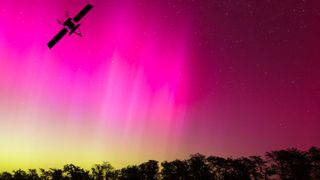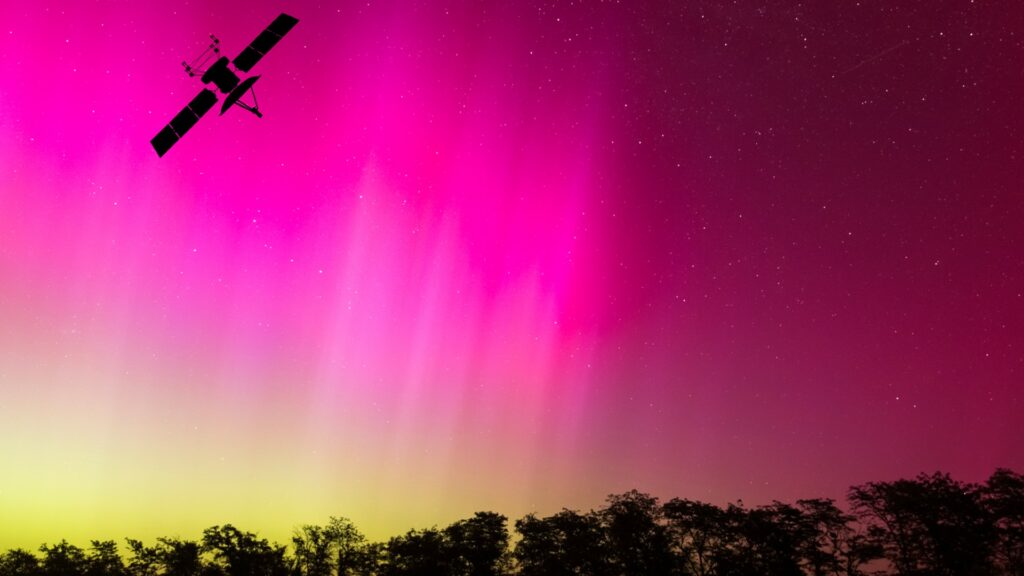
A rendering showing a silhouette of a satellite against a colorful aurora.
(Image credit: Anton Petrus/Getty Images)
The May solar superstorm that set the night sky around the world ablaze with colorful aurora displays also triggered chaos in orbit as thousands of satellites had to maneuver at the same time to maintain their altitude amid the sudden thickening of the upper atmosphere.
According to a pre-print paper published on the online repository arXiv on June 12, satellites and space debris objects in low Earth orbit — the region of space up to an altitude of 1,200 miles (2,000 kilometers) — were sinking toward the planet at the speed of 590 feet (180 meters) per day during the four-day storm.
To make up for the loss of altitude, thousands of spacecraft began firing their thrusters at the same time to climb back up. That mass movement, the authors of the paper point out, could have led to dangerous situations because collision avoidance systems didn’t have time to calculate the satellites’ changing paths.
The solar storm that battered Earth from May 7 to 10 reached the intensity of G5, the highest level on the five-step scale used by the National Oceanic and Atmospheric Administration (NOAA) to assess the strength of solar storms. It was the strongest solar storm to hit Earth since 2003.
The authors of the paper, however, pointed out that the environment around the planet has changed profoundly since that time. While only a few hundred satellites were orbiting Earth twenty years ago, there are thousands today. The authors of the paper put the number of “active payloads at [low Earth orbit]” at 10,000.
“The May 2024 geomagnetic storm was the first major storm to occur during a new paradigm in low Earth orbit satellite operations dominated by commercial small satellites,” the authors of the study, William Parker and Richard Linares from the Massachusetts Institute of Technology, wrote.
Solar storms, triggered by massive eruptions of charged gas from the sun, disturb Earth’s magnetic field. As a result, charged solar particles penetrate deep into Earth’s atmosphere where they interact with molecules of air. These interactions give rise to the awe-inspiring northern lights and southern lights but also heat up the atmosphere and make it swell. As a result, the density of sparse residual gases at the altitudes where satellites orbit increases. The satellites, suddenly struggling against a much thicker medium, begin losing altitude.
Breaking space news, the latest updates on rocket launches, skywatching events and more!
The new paper points out that space weather forecasts ahead of the May storm failed to accurately predict the duration and intensity of the event, making satellite collision predictions nearly impossible.
“The storm represented a serious challenge for the existing conjunction assessment infrastructure as it produced large, unpredictable perturbations on satellite trajectories in low Earth orbit,” the authors wrote. “Automated station-keeping, especially from the Starlink constellation, caused nearly half of all the active satellites in [low Earth orbit] to maneuver at once in response to the storm. The combination of unpredictable satellite drag and bulk maneuvering made it very difficult or impossible to identify potential conjunctions during the storm and in the days that followed.”
On the upside, the storm helped to clear out some junk as defunct satellites and debris fragments spiraled deeper into the atmosphere. The authors of the report estimate that thousands of space debris objects lost several kilometers in altitude during the storm.
More powerful solar storms can be expected in the coming months as the peak of the current solar cycle — the 11-year ebb and flow in the number of sunspots, solar flares and eruptions — is expected in late 2024 and early 2025.
The paper was accepted for publication in the journal of Spacecraft and Rockets.
Join our Space Forums to keep talking space on the latest missions, night sky and more! And if you have a news tip, correction or comment, let us know at: community@space.com.
Tereza is a London-based science and technology journalist, aspiring fiction writer and amateur gymnast. Originally from Prague, the Czech Republic, she spent the first seven years of her career working as a reporter, script-writer and presenter for various TV programmes of the Czech Public Service Television. She later took a career break to pursue further education and added a Master’s in Science from the International Space University, France, to her Bachelor’s in Journalism and Master’s in Cultural Anthropology from Prague’s Charles University. She worked as a reporter at the Engineering and Technology magazine, freelanced for a range of publications including Live Science, Space.com, Professional Engineering, Via Satellite and Space News and served as a maternity cover science editor at the European Space Agency.
>>> Read full article>>>
Copyright for syndicated content belongs to the linked Source : Space.com – https://www.space.com/may-solar-storm-largest-mass-migration-satellites
